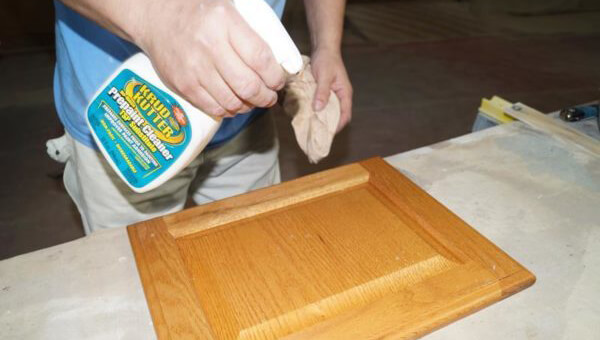How to Use Deglosser on Trim – Effectively In 6 Simple Steps
Are the old trims of your windows and doors worn out? Do you consider giving them a new look? Well, I assume you’re in the right place.
Let me share a little personal experience. My grandmother called me the other day, and she was talking about the trims of her doors. She told me they need a re-finish or a new coat of paint.
Reaching there, I knew the trims needed a lot of work. So, I suggested a good prep before she started the painting process.
And during the prep, we were kind of confused about whether we should use sander or deglosser. Finally, we decided on the deglosser, and I’ll tell you why just keep reading.
Though it is a simple task to carry out, it needs to know the instructions correctly. So for your convenience, I’ve given an accurate idea of how to use deglosser on trim right here.

Table of Contents:=>
- How to use Deglosser on Trim: In just six simple steps
Preparation before applying finish: why is deglossing necessary?
As the saying goes,” a proper preparation gives a good result.” It applies to woodworks as well.
If you want to apply a new coat of paint or re-finish the woodworks, considering the preparation well is a better idea.
For re-varnishing or re-painting on trims, I’d suggest taking the time to do the prep work first. Yes, you can shortly add a quick coat of paint over another, but I assure you it will not last long or give you the finish you desire.
That’s when you need a deglosser. I prefer deglosser over sanding, and you might ask why.
Well, the reason is, trims mostly have detailed edges and precision structures. I do not want to take risks of any kind of alteration or change in the design while I use rough sanders on them.
Again, sanding does not give the desired finish that deglossers do. Since deglosser can easily reach the detailing, nooks, and crannies of the trim, it’s another reason why I’d choose the deglosser.
How to use Deglosser on Trim: In just six simple steps
Here we come to the main conversation. Let me tell you how to apply deglosser on trims in the easiest method that will hold the finish for longer than you imagine! Must Read: best deglosser for Trim.
1st Step: Protect the floor
As the deglosser is a chemical solution, you need to make sure you do not cause any harm to the ground or surroundings while you do the work on trims.
Working in my granny’s house, I made sure to protect the floor beforehand. I used a solvent-resistant drop cloth to cover the area around and below the trims.
For additional protection, I even used newspapers on the drop-cloth to protect from any further spills.
2nd Step: Use the TSP Substitute before Deglosser
Some people use the deglosser directly on the surface of the trim. I would not suggest the same, though.
I recommend using a TSP substitute before you apply the deglosser. And why is that?
You need your new finish to bond well with the surface for a longer-lasting application. The TSP will just make it more durable and add longevity to your trims.

People use it to eliminate any kind of oil or grease from the surface that offers a better bonding area for future paint application or finish.
It is a primary step, just pour a few drops of TSP substitute on a clean rug and rub the trim in a circular way for better results. Do as directed on the container or bottle.
3rd Step: Take a clean cloth
You need a clean cloth to apply the deglosser. I prefer lint-free cloth.
As the deglosser includes chemical content, a lint-free cloth would be an ideal choice when using it. It does not end up giving a fluffy look or modify fiber bonding.
It gives a better outcome with no extra hassle with the fiber. if you have not any TSP cleaner at your home, you can use any heavy-duty kitchen degreaser, but it is not work as like TSP substitute.
4th Step: Apply the Deglosser
It is probably the most exciting and fun step to do. Trust me; it includes zero-mess and hassle.
Soak the cloth with the deglosser and wipe the trim surface in gentle circular moves. The fabric will end up being soiled quickly, no need to worry! Fold the exposed surface of the cloth for a new clean surface, or you can simply use another piece of fabric. Not a big deal, right?

Make sure to clean the trim thoroughly to remove any sort of white haze, dirt, or sheen off of the surface.
5th Step: Paint with the deglosser
You have already applied the deglosser with the cloth. But for a smoother finish, I recommend the application of another coat of deglosser.
I prefer using a 2-inch paintbrush to apply the deglosser. Give an elegant smooth coat and wait for it to dry.
6th Step: Let it dry
The secret of making your deglosser do its job efficiently is patience. After the application of the deglosser, wait for a while.
The waiting phase may take up to 30 minutes. And it’s not much of time, more like a coffee break.
There will be directions on the deglosser bottle for painting and drying. Read the instructions carefully and do as directed.
Make sure to wait until it completely dries so that when you use new paint over the surface, the deglosser gives it an excellent bonding strength and plane to hold on to for a long time.
You can follow the steps to ensure the longevity of your paint on trims. It gives you a guaranteed 5-10 years of zero work on the trims.
What are the safety measures you need to take beforehand?
Working with a chemical solution can sometimes make you afraid, especially if you are a newbie. But the deglosser does not require large safety measures, just the basic ones.
For total safety, while working with it, remember to follow the precautionary steps-
- Do not forget to wear your safety goggle because you don’t want the chemicals to get in your eyes.
- Remember to wear your safety gloves to prevent any spillage from the deglosser to your hands. Otherwise, it may cause irritation or rashes.
- For protecting the surroundings from any damage, cover them with clothes or newspapers.
- Keep your windows and doors open for good air circulation or for removing any chemical odor or fumes whatsoever.
You should never compromise with safety!
Which one is better for a trim? Sanding vs. Deglossing
Let’s get something straight here; sanding and deglossing do not serve the same purpose. So what we need to know is their work and use.
Sanding:
Sanding is done to smoothen the uneven surfaces by removing chunks of adhered materials from the surface with the help of an abrasive. Hence, for irregular surfaces or smoothening before re-paint or re-finish, you need to do some sanding there.
Sanding involves the generation of a lot of dust and dirt, which can create a ruckus. And this can also lead to health concerns as well.
Speaking of trims, they are delicate, fine woodworks that require precision for preparation before applying any wood finish. Sandpapers take much difficulty to reach there. Again, time and effort will matter a lot too.
Now, let’s talk about using a deglosser.
Deglosser:
Liquid sander or deglosser is a chemical solution to remove the gloss over any previously applied finish so that you can use a new finish with a better bonding surface with the woodwork.
Deglosser only dulls the surface and delivers a better bonding area for the application of a new finish or coat of paint.
What I think is due to the delicacy and fineness of trims of doors, windows, and what so ever, sanding would do a better job. It is easy for deglosser to reach detailed works and corners. And again, with less effort, you can get more work done.
However, many times when the trims are too worn out with irregular planes, there cannot be an alternative to sanding. Now, it’s your preference that needs to you need to take into consideration.
Final thoughts:
Even if you had earlier confusions as for how to use deglosser on trim, after this discussion, I’m sure you are clear about that too.
Before any woodwork, you need to observe the materials, the condition, the necessity of using any products. So, after you have analyzed all these well, you can move on to the implementation.
Deglosser is a handy solution to use for your woodworks, especially the trims. Now you know what to do for re-finishing the trims with less work and struggle. Get going without further adieu!
Last Updated on October 13, 2020 by Rogers Weber
[As an Amazon Associate I earn from qualifying purchases.]


